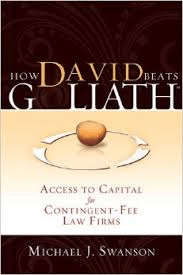How David Beats Goliath: Access to Capital for Contingent-Fee Law Firms
 | |
| Author | Michael J. Swanson |
|---|---|
| Country | United States |
| Language | English |
| Genre | Non-Fiction |
| Publisher | Advantage Media Group |
Publication date | 2011 |
| Media type | Paperback |
| Pages | 139 |
| ISBN | 9781599322506 |
How David Beats Goliath: Access to Capital for Contingent-Fee Law Firms is a 2011 book written by American businessman and financial expert, Michael J. Swanson.[1] The book details the basic financial operation of contingent-fee law firms and outlines the methods used to secure funding for cases.[2] All proceeds from the book are donated to the American Association for Justice's Seventh Amendment Fund, which is designed to help protect the right to a trial by jury.[3][4]
Background
Michael J. Swanson has a background in business starting in 1989 as the first employee of Champion America Inc., where he eventually became General Manager. He then took over as the CEO of Advocate Capital, Inc., a law firm financing agency, in 2000.[5] At Advocate Capital, Inc., Swanson deals almost exclusively with contingent-fee law firms.[6] Swanson wrote the book based on his experience with the financial statements of law firms throughout his career.[5] His business partner, Dan Taussig, and colleague, Harlan Schillinger (who would later become his literary agent), convinced him to write the book in 2010.[5]
Summary
The book is split up into three sections: Background, Review of Capital Sources, and Application.[7] The first section details basic operational practices that contingent-fee law firms employ. In this section, it notes that many contingent-fee law firms have to front money (or capital) for individual cases. The first section also discusses standard accounting and financial precepts (e.g. the time value of money and assets)[8] that may not be traditionally covered in any law-based education.
The second section details 10 different sources of capital available for contingent-fee law firms. Each of these sources are listed in order from most to least expensive for the firm,[9] and include the following:[1]
|
|
|
Each of these sources of capital has its own chapter in which it details the pros and cons.[10] Swanson notes that many firms opt to self-finance either with partner's cash or credit cards. The book never explicitly points out which form of funding is best, noting that there are many variables that may make one source better than another. Swanson notes that, despite the wealth of options at their disposal, many contingent-fee law firms end up with a lackluster asset.
The third and final section of the book talks about how contingent-fee firms can utilize their capital more efficiently and get better deals from lenders and financing companies.[1] It suggests that financially minded law firms will have a better chance of success than those that focus entirely on their cases.[7]
Reception
The book has been reviewed favorably in trade publications and online outlets. Most reviews have referred to the book's information as valuable for contingent-fee law firms and trial lawyers. Douglass F. Noland of TRIAL Magazine suggested that the book was "a must-read for any lawyer who works on contingent-fee cases," and that "if Swanson’s strategy is applied faithfully, lawyers may lessen their worries about financing their cases, so they can concentrate more on the cases themselves."[8] Writing for Trial News, Morris H. Rosenberg noted that "an attorney needing to raise capital can get a quick overview of the sources available by reading this book."[10]
Other reviews referenced the book's relative compactness and ease of reading. Jeffrey Isaac Ehrlich of Advocate Magazine referred to the book as "a fast-read" that succeeds in "helping lawyers think about the financial challenges they face, instead of just blindly doing what they have been doing."[7] The book has received almost universal acclaim from trade publications.[6] A review from RD Legal Funding noted that the book "does a great job explaining the purpose of legal funding" and "how it can ultimately help the broken model of finance for law firms."[11]
References
- 1 2 3 Zoukis, Christopher (1 December 2014). "How David Beats Goliath: A Trial Lawyer's Guide to Financial Management". The Huffington Post. Retrieved 10 December 2014.
- ↑ Diana (9 September 2014). "How the Changing Landscape of Legal Funding Affects Contingent-Fee Law Firms". PHX News. Retrieved 10 December 2014.
- ↑ Radic, Randall (11 December 2014). "Book Review: How David Beats Goliath by Michael J. Swanson". Blog Critics. Retrieved 26 December 2014.
- ↑ Ecksel, William (1 December 2013). "Book Review: Start-Up Advice For Lawyers in How David Beats Goliath". Capital Press. Retrieved 10 December 2014.
- 1 2 3 Millers, Samantha (19 November 2014). "How Michael J. Swanson Became an Advocate for Trial Lawyers". The Epoch Times. Retrieved 10 December 2014.
- 1 2 Dye, Eric (23 June 2013). "How David Beats Goliath - Access to Capital for Contingent-Fee Law Firms with Michael J. Swanson". Epodcast Network. Retrieved 10 December 2014.
- 1 2 3 Ehrlich, Jeffrey Isaac (April 2012). "How David Beats Goliath". Advocate Magazine.
- 1 2 Noland, Douglass F. (June 2012). "Battle Contingencies". TRIAL Magazine. p. 54.
- ↑ Graves, Harmon S. (May 2012). "Book Reviews". The Colorado Lawyer. p. 76.
- 1 2 Rosenberg, Morris H. (March 2012). "Funding alternatives for contingency fee firms". Trial News. p. 16.
- ↑ ""How David Beats Goliath" by Michael J. Swanson of Advocate Capital, Inc.". RD Legal Funding. 20 June 2012. Retrieved 11 October 2014.